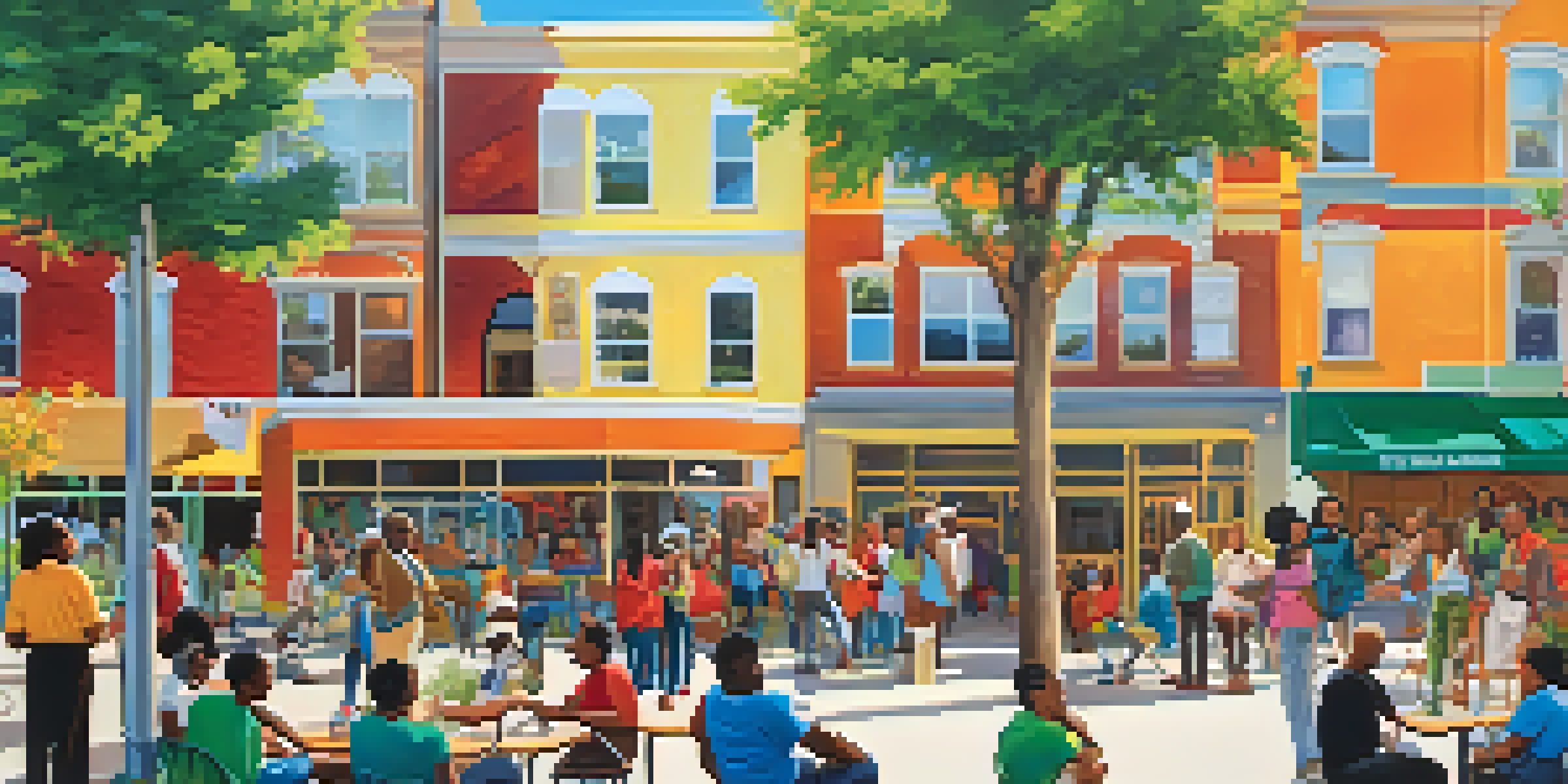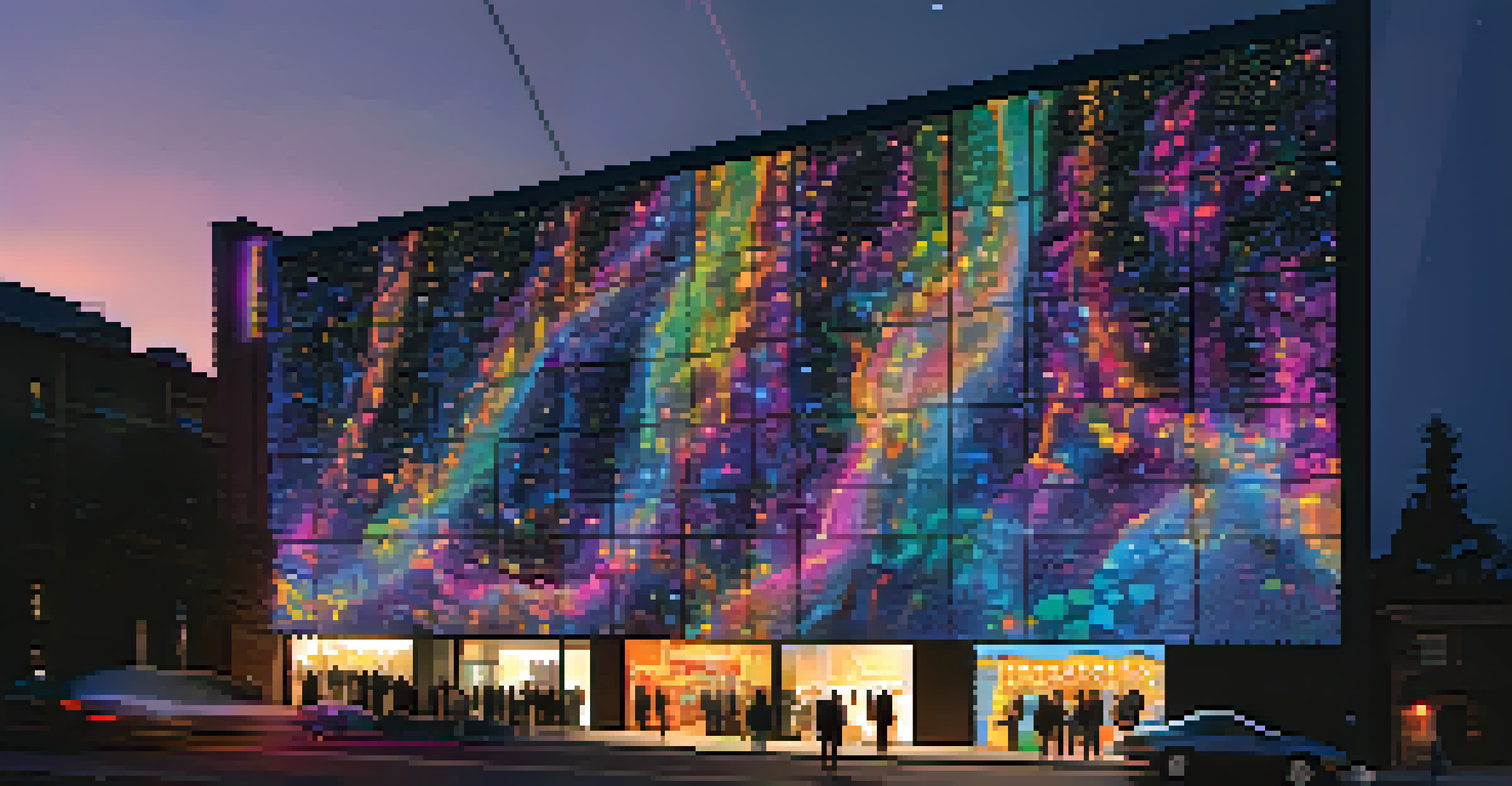The Role of Public Art in Urban Development and Society

Public Art: A Catalyst for Community Engagement
Public art serves as a powerful tool for fostering community engagement. By transforming vacant spaces into vibrant art installations, cities can inspire residents to connect with their surroundings. This connection not only beautifies the area but also encourages local participation in cultural activities.
Art is not what you see, but what you make others see.
For instance, a mural depicting local history can spark conversations among residents, creating a shared sense of identity. Such art pieces often become landmarks, inviting both locals and tourists to gather and share experiences. This interaction strengthens community bonds, as people come together to appreciate and celebrate art.
Moreover, public art projects often involve local artists, providing them a platform to express their creativity. This inclusivity not only highlights diverse voices but also promotes a sense of ownership among community members. As a result, public art becomes a catalyst for collaboration, encouraging residents to envision their neighborhoods in new ways.
Enhancing Urban Aesthetics Through Public Art
One of the most immediate impacts of public art is its ability to enhance urban aesthetics. Dull cityscapes can be transformed into visually appealing environments through well-placed sculptures, murals, and installations. This transformation can turn a simple street into a gallery, making the urban experience more enjoyable for everyone.

For example, cities like Philadelphia and Melbourne have successfully integrated public art into their landscapes, creating vibrant cultural hubs. These cities showcase how art can soften harsh urban environments, making them more inviting. A colorful mural can brighten a gray wall, while a sculpture can provide a striking focal point in a busy plaza.
Public Art Boosts Community Ties
Public art fosters local engagement by transforming spaces and creating opportunities for residents to connect and share experiences.
In addition to beautifying spaces, aesthetically pleasing urban environments can have economic benefits. Improved visual appeal can attract businesses, tourists, and residents alike, contributing to the local economy. When people enjoy their surroundings, they're more likely to spend time—and money—there, further enriching the community.
Public Art as a Reflection of Cultural Identity
Public art often serves as a canvas for expressing cultural identity, reflecting the unique history and values of a community. From murals that depict local legends to sculptures that celebrate cultural diversity, these artworks contribute significantly to cultural representation. They remind residents of their heritage and provide a sense of pride in their community.
Public art is a vital part of community engagement and cultural identity.
Take, for example, the various art installations found in neighborhoods with rich cultural backgrounds. These pieces not only tell a story but also invite dialogue about cultural heritage and social issues. Through public art, communities can engage in discussions that might not otherwise take place, fostering a deeper understanding among residents.
Additionally, public art can help to preserve cultural narratives that might be at risk of being forgotten. By visually representing these stories in public spaces, artists ensure that future generations remain connected to their roots. This preservation is vital for maintaining the cultural fabric of a community.
Public Art: A Tool for Social Change
Beyond aesthetics and identity, public art plays a crucial role in driving social change. Artists often use their work to address pressing social issues, raising awareness and encouraging dialogue among the public. This art can be a powerful medium for challenging the status quo and inspiring action.
For instance, street art has been pivotal in movements advocating for social justice, capturing the voices of marginalized communities. These pieces can provoke thought and stir emotions, sparking conversations that lead to meaningful change. In this way, public art becomes a form of activism, pushing boundaries and amplifying voices that need to be heard.
Economic Gains from Art Investments
Investing in public art stimulates local economies by attracting tourists and increasing property values in urban areas.
Moreover, when communities come together to support socially conscious art, they foster a culture of activism. This collective effort can lead to significant impacts, as residents rally around shared goals. Public art not only beautifies spaces but also serves as a testament to the power of community engagement in advocating for social change.
Economic Benefits of Public Art in Urban Areas
Investing in public art can yield significant economic benefits for urban areas. By attracting tourists and residents alike, art installations can stimulate local economies and encourage spending. A vibrant art scene can lead to increased foot traffic, benefiting nearby businesses and boosting overall economic activity.
Cities with established public art programs often see a surge in tourism, as visitors seek out unique cultural experiences. Events such as art walks or festivals centered around public art can draw crowds, further promoting local businesses. This economic boost is particularly crucial for small businesses that rely on community engagement.
Additionally, public art can increase property values in the surrounding areas. Neighborhoods with attractive art installations often become more desirable places to live, leading to rising real estate prices. This positive effect can help revitalize struggling urban areas, making public art an essential component of urban development strategies.
Fostering Inclusivity Through Public Art
Public art has the potential to foster inclusivity within urban environments. By involving diverse artists and communities in the creation of art projects, cities can ensure that a wide range of perspectives and experiences are represented. This inclusivity enriches the cultural landscape and promotes a sense of belonging among residents.
For example, community art projects that invite participation from various demographics encourage dialogue and understanding. When people from different backgrounds come together to create, they build bridges and develop empathy. This collaborative process can strengthen community ties and foster a more inclusive atmosphere.
Art as a Vehicle for Social Change
Public art serves as a powerful medium for addressing social issues, encouraging community dialogue and activism.
Moreover, public art can serve as a platform for underrepresented voices, allowing them to share their stories and experiences. By highlighting these narratives, cities can create a more equitable cultural environment. Ultimately, fostering inclusivity through public art encourages communities to embrace diversity and celebrate their unique identities.
The Future of Public Art in Urban Development
As urban areas continue to evolve, the role of public art in development will only become more significant. With the rise of technology and social media, artists are finding new ways to engage audiences and share their work. This shift opens up exciting possibilities for public art, blending traditional techniques with innovative approaches.
For instance, digital art installations are becoming increasingly popular, allowing cities to showcase art in dynamic and interactive ways. These installations can adapt to their surroundings, creating immersive experiences for viewers. As technology continues to advance, public art will likely evolve, embracing new mediums and formats.

Moreover, urban planners are recognizing the importance of integrating public art into their development strategies. By prioritizing art in urban design, cities can create spaces that are not only functional but also engaging and inspiring. The future of public art promises to be a vibrant tapestry woven into the fabric of urban life.